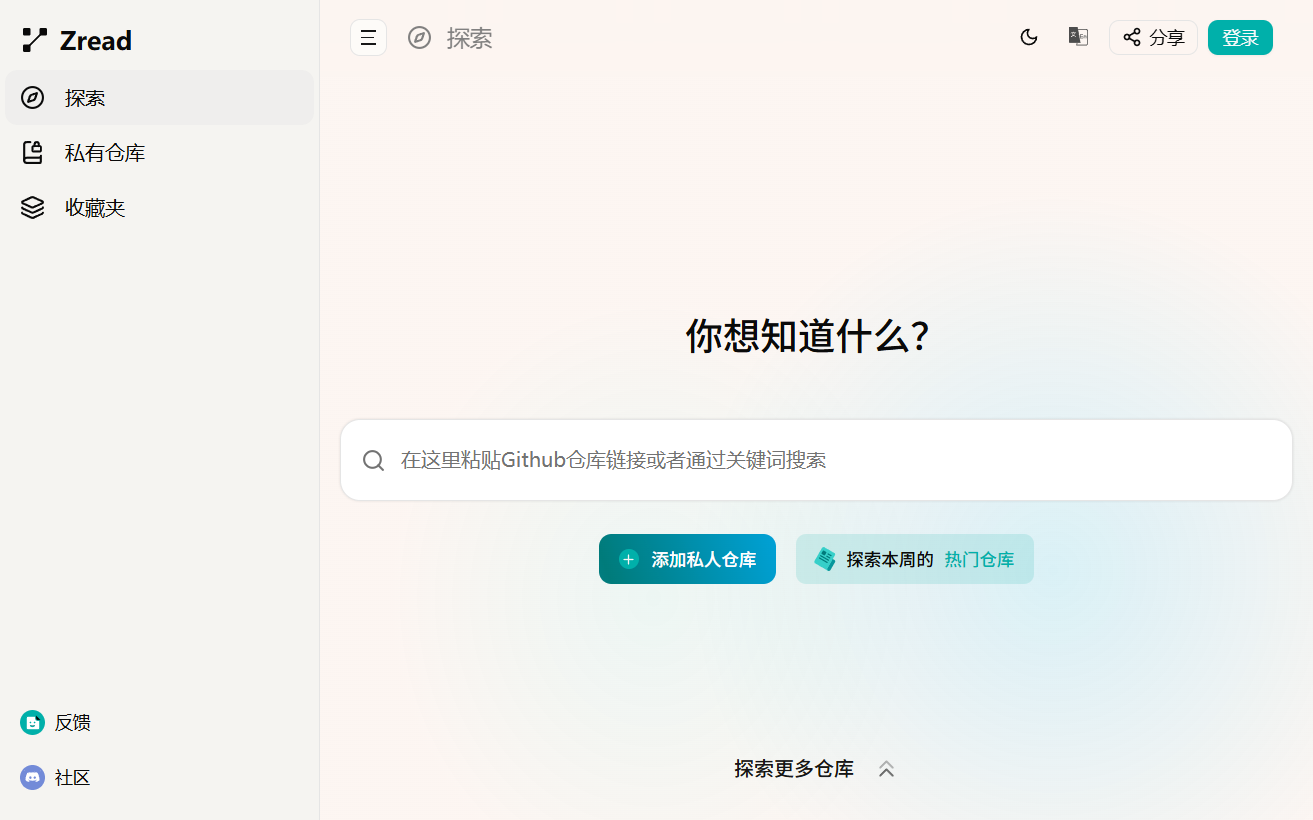Zread is an online tool focused on helping developers quickly understand the structure of open source code. It uses artificial intelligence technology to analyze user-provided GitHub project links and generate clear project structure, functional descriptions, and code logic analysis reports. zread.ai's core goal is to lower the threshold for developers to read and understand complex open source projects, which is especially suitable for programmers or teams who need to get started with new projects quickly. Zread.ai is developed by Smart Spectrum AI, focusing on providing intuitive and easy-to-understand code analysis, and currently supports free use for individual developers or small teams to quickly explore open source projects.

Function List
- Analyze GitHub projects: Users enter a link to a GitHub project, and the system automatically parses the code base to generate an overview of the project structure.
- Provide a clear project structure: organize code files, directories and modules to show the hierarchical relationship of the project.
- Functional Module Description: Extract the core functionality from the code and generate a concise functional description.
- Code Logic Analysis: Analyze code logic and provide descriptions of key functions and modules to help users understand code implementation.
- Support for multi-language projects : support for analyzing open source projects in multiple programming languages , such as Python, JavaScript , etc. .
- Free to use: no registration or payment required, just paste the link to use the core functions.
Using Help
How to use Zread.ai
Zread.ai is very easy to use, there is no need to install any software, users can simply visit https://zread.ai/ to get started. Below is the detailed procedure:
- Access to the website: Open your browser and type https://zread.ai/ to get to the Zread.ai homepage. The homepage has a simple interface with an input box in the center for pasting GitHub project links.
- Enter the GitHub link: Paste the link to the GitHub project you want to analyze in the input box, e.g.
https://github.com/owner/repositoryMake sure the link points to a public code repository. Make sure the link points to a public code repository; Zread.ai does not currently support private repository analysis. - Submission of requests for analysis: Click the "Analyze" or "Start" button next to the input box (the name of the button may change due to version updates). The system will automatically pull the code base and start analyzing it, which usually takes a few seconds to a few minutes depending on the size of the project.
- View Analysis Results: Once the analysis is complete, the page displays the structured results, including the following sections:
- Overview of the project structure: Show the directory structure of the codebase as a tree diagram or list, presenting a clear picture of how files and folders are organized.
- Functional Module Description: List the main functional modules of the project, such as core classes, functions, or API endpoints, with a short description.
- Code Logic Analysis: Provide natural language explanations for key code segments to help users understand the implementation logic of the code.
- Export or share results: Users can copy the results of the analysis or send them to team members through the sharing feature provided on the page. Some of the results are supported to be exported in Markdown format for easy documentation or integration into documents.
Featured Functions Operation Procedure
1. Project structure analysis
The core function of Zread.ai is to generate a clear project structure. After a user submits a GitHub link, the system scans all the files and directories in the codebase and generates a hierarchical structure. For example, for a Python project, Zread.ai recognizes that src The main modules, configuration files, and test files in the folder are displayed in a tree view. Users can click on a directory or file to view the specific contents or jump to the corresponding GitHub code page.
2. Description of functional modules
Zread.ai extracts the main functional modules in the code, such as routing functions for a web project or model training functions for a machine learning project. It describes what each module does in simple terms. For example, for a Flask project, Zread.ai might generate the following description:
/app/routes.py: Defines the API endpoints for user login and registration, including JWT authentication logic.
Users can click on the module name to see more detailed code snippets and logic descriptions.
3. Code logic analysis
For complex code, Zread.ai parses the logic of key functions or classes. For example, for a Python project containing machine learning models, Zread.ai might analyze train_model() function, describing its input parameters, training flow, and output results. This kind of analysis is especially useful for developers unfamiliar with the code base to quickly understand the core logic of the code.
4. Multilingual support
Zread.ai supports project analysis in a variety of programming languages, including Python, JavaScript, Java, Go and so on. Users do not need to specify the language, the system will automatically recognize the language of the code base and adjust the analysis strategy. For example, when analyzing a Node.js project, Zread.ai will focus on analyzing package.json and main JavaScript files, extracting dependencies and core functionality.
caveat
- Link format: Make sure you enter the correct GitHub link in the format
https://github.com/用户名/仓库名The - Project size: For very large projects, the analysis may take longer and users are advised to keep the page open during the analysis.
- public warehouse: Zread.ai currently only supports public GitHub repositories, private repositories require user authorization (which may be supported in the future).
- Language Support: While multiple languages are supported, some niche languages (such as Rust or Haskell) may not be analyzed in sufficient depth.
sample operation (computing)
Suppose the user wants to analyze the n8n project (an open source workflow automation tool). The steps of the operation are as follows:
- Visit https://zread.ai/.
- Paste in the input box
https://github.com/n8n-io/n8nThe - Click on the "Analyze" button.
- Wait approximately 30 seconds to view the results page. Results may include:
- Project structure: presentation
src,packagesetc., listing major files such asworkflow.tsThe - Functional Module: Describes the core functionality of n8n, such as workflow definition, node management, and API integration.
- Logic analysis: parses the logic of the workflow execution function, showing how input data and trigger nodes are handled.
- Project structure: presentation
Users can click on any module in the results to see a more detailed description or jump directly to GitHub to view the code.
application scenario
- Getting started quickly with a new program
When a developer joins a new project and is faced with an unfamiliar codebase, Zread.ai quickly generates an overview of the structure and functionality, helping the developer to get a full picture of the project and save time reading the code. - Teamwork and knowledge sharing
Development teams can share Zread.ai's analytics with new members to help them quickly familiarize themselves with the project, suitable for remote collaboration or cross-team development. - Learning open source projects
Students or beginners use Zread.ai to analyze well-known open source projects (such as TensorFlow or React), quickly understand the code structure and functional implementation, and improve learning efficiency. - Code Review and Optimization
When reviewing open source code, Zread.ai's logic analysis feature can help identify key modules and assist in optimizing or refactoring code.
QA
- Does Zread.ai require registration or payment?
Zread.ai currently offers free analytics with no registration or payment required. Users can access it by visiting the website and pasting the GitHub link. - What types of GitHub projects are supported?
Zread.ai supports public GitHub repositories covering a wide range of programming languages, such as Python, JavaScript, Java, and so on. Private repositories are not supported. - Can the analysis results be exported?
Yes, some of the results support exporting in Markdown format for users to save or share. - How long does it take to analyze large projects?
Typically it takes a few seconds to a few tens of seconds for small projects, and can take up to 1-2 minutes for large projects, depending on the size of the codebase. - How does Zread.ai ensure analytical accuracy?
Zread.ai's model training based on Wisdom Spectrum AI, combined with static code analysis technology, ensures accurate results. However, for complex or niche language projects, it is recommended that users incorporate manual review.



































